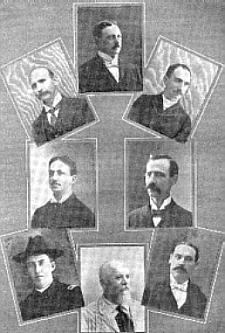
The criminal element began looting the dead,
and the cold blooded commercial element began looting the living.
The criminals were stealing everything they could with safety lay hands
on, and the mercenary commercial pirates began a harvest of extortion.
The price of bacon was pushed up to 50 cents a pound, bread 60 cents a
loaf, and owners of small schooners and other sailing craft formed a trust,
and charged $8 a passenger for transportation just across the bay from
the island to the mainland.
Every part of the city was patrolled by 6 PM, but one evening a squad was besieged at St. Mary's Hospital. The squad was surrounded by a horde of armed thieves. Several hundred shots were exchanged. Sergeant Camp killed four looters with his rifle, and about ten or twelve were killed by the squad. The solders then began picketing the city doing fourteen hours' duty without rest.
By the third day after the storm, 75 men who had been caught robbing the dead, had been shot and killed. One of these had in his pocket twenty-three human fingers with costly rings on them. The fingers had been cut from the victims of of the storm found on the beach, or floating in the waters of Galveston Bay.
The Mistrot House, in the West End, was turned into a hospital, as all of the regular hospitals of the city were unavailable.
The officers of the National Government took steps at once to render all possible aid. The President sent telegrams of sympathy to the TX Governor and the Mayor of Galveston, and promised to send all possible relief.
Miss Clara Barton, founder of the American Red Cross, issued an appeal in behalf of the Texas sufferers, and traveled to Galveston accompanied by Mary Agnes Coombs, the Secretary of the Executive Committee in New York during the Spanish War.
The steamer Lawrence arrived in Galveston on
the morning of the 11th, from Houston, with water and provisions.
A committee of 100 citizens were aboard, among them being doctors and cooks.
.

Surgeon-General Walter Wyman dispatched Passed Assistant Surgeon Wertenbaker to Galveston, from New Orleans.
An appeal was made to Houston druggists: The storm stricken district is very much in need of the following drugs: Iodoform, chloride of lime, gum camphor, assafetida, crude carbolic acide, phenol sodique, gauze bandages, quinine and idoform gauze.
An exodus was begun from the island. Hundreds fled to Houston, and hundreds more were eager to go, but were unable to secure transportation. Along the bay front were scores of families with dejected faces, pleading to be taken from the stricken city, where, in spite of every effort to restore confidence, there was a universal feeling of depression.
For a week Galveston was under martial law. There were no disorder, although there was some robbing of the dead by ghouls. This was checked by a punishment swift and sure, as marshals were granted permission to carry and use guns. One hundred and twenty-five men were shot to death for robbing the dead.
Every able-bodied man was pressed into service. Volunteer gangs continued their work of hurried burial of the corpses, but many groups were forced into labor at bayonet point, and watched carefully by gun-bearing marshals and soldiers. Whisky by the bucketful was carried to these men, and they were drenched with it. The stimulant was kept at hand and applied continuously. Only in this way was it possible for the stoutest-hearted to work in such surroundings.
Even after the bodies had been disposed of, the danger of an epidemic threatened the survivors. Many of the people gave way to physical exhaustion. They had been compelled to subsist upon unwholesome food, drink, polluted water, and breathe the foul air of their unsanitary surroundings. Consequently, the death toll continued to mount from disease, and injuries sustained during the storm.
Five days after the storm, a battery man on duty a the forts was picked up on Morgan's Point, injured by alive. He had buffeted the waves for five days and lived through a terrible experience. Morgan's Point is 30 miles from Galveston.
At 1:15 PM Friday, September the 14th, the Postal Telegraph and Cable Company received a bulletin from Galveston stating that wire connection had been made across the bay by cable, and that direct communication with the island city was resumed with two wires working, and that two more would be ready by the next day.
The women of Galveston worked as never before. Wherever one went, they were met with the sight of carpets and clothing and mattresses and rugs hung on fences and galleries. The scrubbing-brushes were going constantly. The smell of carbolic acid was in the air. The housekeepers were bustling in and out.
Gradually some businesses began to prepare for reopening. Merchants and clerks overhauled stocks. Where the articles were such that it could be done, they were carried out in front of the stores and spread in the sun to dry. Tons of dry goods, clothing, hats and caps, boots and shoes were spread in the streets and on the pavements, so that in places was difficult to get past.
All the while, carts with disinfectants were going through the streets, and the gutters were being covered with lime. Carpenters were having all the work they could do, as many families continued to live in their roofless homes.
Sealy Hospital, the gift of the late John Sealy, was one of the largest institutions of Texas. Very serious damage was sustained. Almost the first work of restoration begun on any public structure was at the Sealy Hospital.